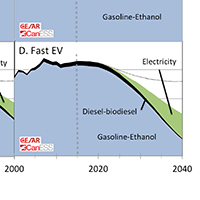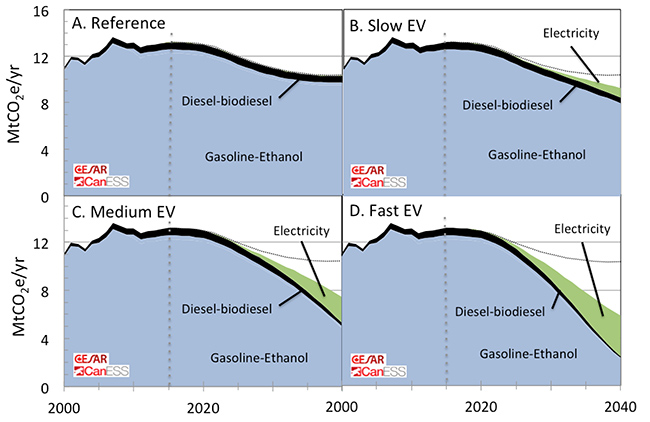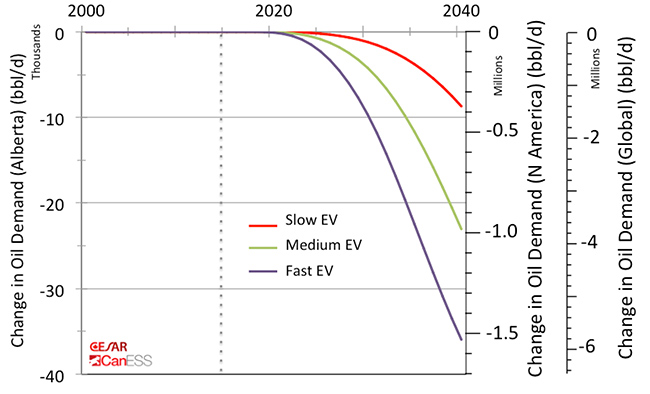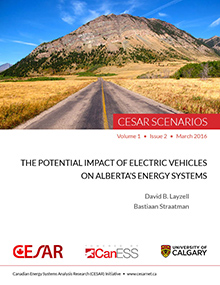Posted on Tue, 03/15/2016 - 06:16
By David B. Layzell and Bas Straatman

By the end of 2014, more than 700,000 plug-in vehicles (plug-in hybrids and pure battery electrics) had been sold worldwide, up from about 400,000 at the end of 2013. Recently, the Ontario government announced that it is updating its consumer incentive program for electric vehicle purchases as part of its climate change plan. The update increases the current incentive for electric vehicles from a range of $5,000 to $8,500 to a range of $6,000 to $10,000, with the potential for additional incentives based on battery size and the number of seats.
Also in the last few weeks, General Motors and Tesla each announced they will soon deliver 200+ mile range (320+ kilometres) electric vehicles at a game-changing price of $30,0000 or less, including tax incentives. GM disclosed last fall that the battery cell for its Chevy Volt will cost just $145 per kilowatt-hour. That is significant, given what a detailed analysis in the journal Nature Climate Change concluded: “If costs reach as low as $150 per kilowatt-hour this means that electric vehicles will probably move beyond niche applications and begin to penetrate the market more widely, leading to a potential paradigm shift in vehicle technology.”
Electric vehicles (EVs) are part of the transformation in personal light-duty vehicle transportation. But when combined with car sharing and self-driving vehicles, the implications of this convergence for the design of our cities, the future role for public transportation, and the jobs available for citizens, are as important for Alberta as the future of the province’s fossil energy industry.
The transformation to plug-in EVs, if it occurs over the next decade or two, is unlikely to be a decision made in Alberta. The same can be said about car sharing and self-driving vehicles. Rather, these transformative technologies will be a result of innovation, public perceptions and marketing strategies developed elsewhere, but they will result in a plethora of new choices for consumers in the province. Municipal, provincial and federal governments may be able to speed or slow this transformation, but they will not be able to control whether or not it occurs if it is moving forward in other parts of North America and the world.
Whether this transformative ‘tsunami’ is good or bad for Alberta – whether the province ‘rides the wave’ or is ‘swamped by it’ – is largely a choice the province and its communities need to make. For example, increasing the benefits of a reduction in greenhouse gas emissions from a shift to EVs would require accelerated retirement of coal-fired power plants. The role that EVs could play in providing electricity storage also needs to be considered.
In a provincial economy dependent upon oil recovery and export, a North American or global transformation to EVs would likely have a negative impact on the price received for each barrel and therefore on the provincial economy. This reality emphasizes the importance of diversifying the province’s economy while improving the efficiency of and reducing the environmental footprint associated with recovering, processing and moving the oil to market.
Policy makers and the public need to be plugged into these potential changes that both threaten and provide opportunity for the province and the communities it supports.

Figure 1. Well-to-wheels greenhouse gas (GHG) emissions associated with the projected energy use of personal vehicles for a reference scenario and three alternative scenarios for EV deployment (Panels A to D). The dashed lines in panels B to D show the total GHG emissions in the reference scenario (Panel A) to illustrate the magnitude of the reduction for each scenario. See Layzell and Straatman (2016) for details.
We at the Canadian Energy Systems Analysis Research (CESAR) initiative have just released a discussion paper on a study we recently completed. Entitled Scenarios for the Future: The Potential Impact of Electric Vehicles on Alberta’s Energy Systems, it explores the potential greenhouse gas and air quality implications for a transition to plug-in electric vehicles in Alberta over the next 25 years, based on an analysis of Alberta’s energy and transportation demand data.
To produce our discussion paper, CESAR partnered with Ottawa-based whatIf? Technologies Inc., the developer and owner of the Canadian Energy Systems Simulator (CanESS) model that CESAR researchers have both contributed to and used to explore past, present and possible future energy systems of Canada.
The scenario models we developed – a reference scenario and three alternative scenarios (“slow,” “medium” and “fast”) for EV deployment – are focused only on light duty EVs for personal transportation. Gasoline-powered light duty vehicles for personal use have the highest carbon footprint of all modes of personal transport. Our models show potential environmental benefits, including lower emissions of greenhouse gases (GHG, see Figure 1) and criteria air contaminants (e.g. particulate matter and hydrocarbon emissions), associated with the transformation from internal combustion engine vehicles to EVs.
However, the projected EV benefits assume that the electrical grid in Alberta becomes significantly cleaner, in terms of GHG emissions, than it is now. Shifting from coal-fired power generation to lower-carbon sources (such as renewables and natural gas) must be a priority. But it is also important that upstream emissions from the lower-emission sources (especially natural gas) are minimized and tightly regulated. The province must ensure that if natural gas replaces coal in generating electricity, it is not as bad as or even worse than coal in the well- or mine-to-grid emissions.

Figure 2. A comparison of the projected reduction in demand for oil, relative the reference scenario for the slow, medium or fast EV deployment scenarios in Alberta. See Layzell and Straatman (2016) for details.
Electric vehicles could transform personal transportation in Alberta, with significant impacts on the province’s environment, economy, energy and transportation sectors, and cities. Our scenarios also showed a reduced demand for crude oil – likely negatively affecting per-barrel price – in Alberta, across North America and globally with increasing EV deployment (Figure 2). This will affect a province like Alberta or a city like Calgary whose economies are dependent on oil production and export to markets. It would be wise to plan and prepare for the pending EV/car sharing/self-driving cars ‘tsunami,’ by encouraging utilities, communities and companies to see it as an opportunity, positioning themselves to be leaders in the change, and providing insights, services and technologies to others.
We encourage you to read our paper and to contribute your comments to the discussion of the potential impacts of electric vehicles on Alberta’s energy systems. We also welcome your suggestions on technology or policy choices that you think would benefit from CESAR’s scenario analysis.
Layzell DB and Straatman B, 2016. The Potential Impact of Electric Vehicles on Alberta’s Energy Systems. CESAR Scenarios (March 2016) Volume 1, Issue 2: 1-26.


Comments
shanenewman replied on Permalink
Impact of electric vehicles
We have found a huge impact of electric vehicles in the environment system. Most probably electric vehicles are helpful for environment system as these are able to reduce pollution and vehicle emission problems. We can say that electric vehicles are able to change the face of transportation system and ultimately save the environment condition.